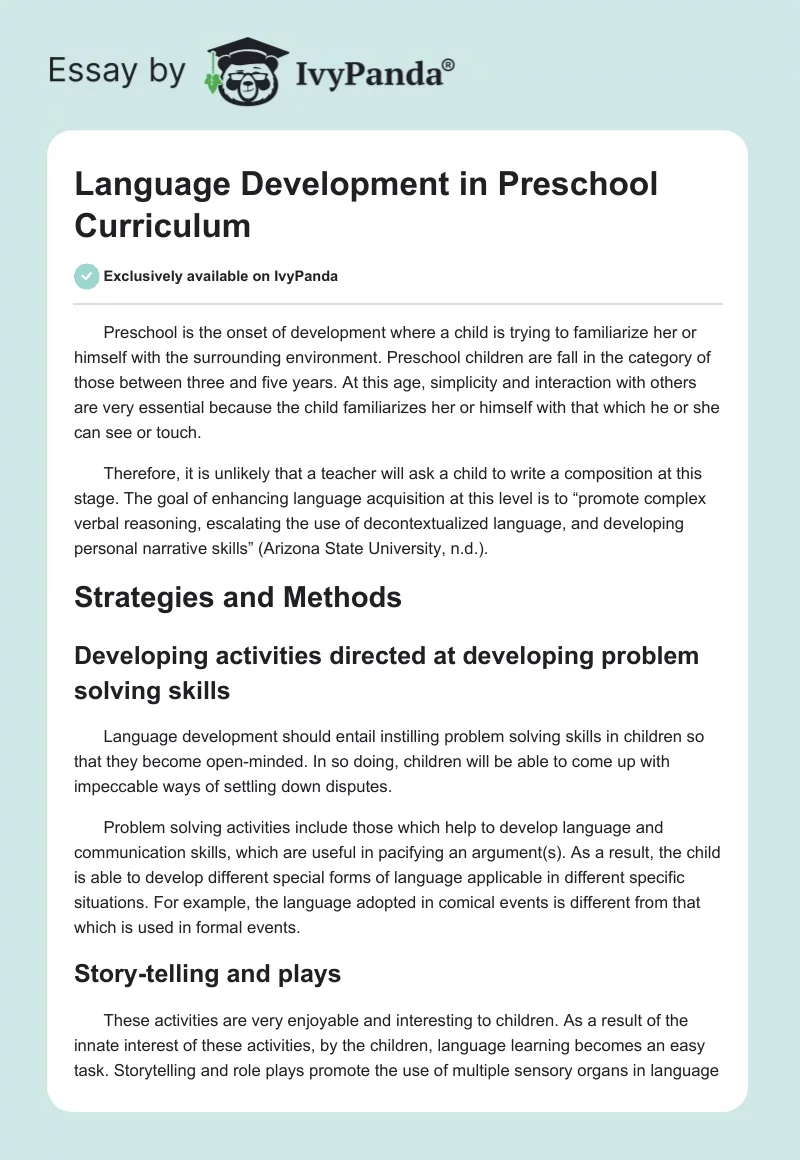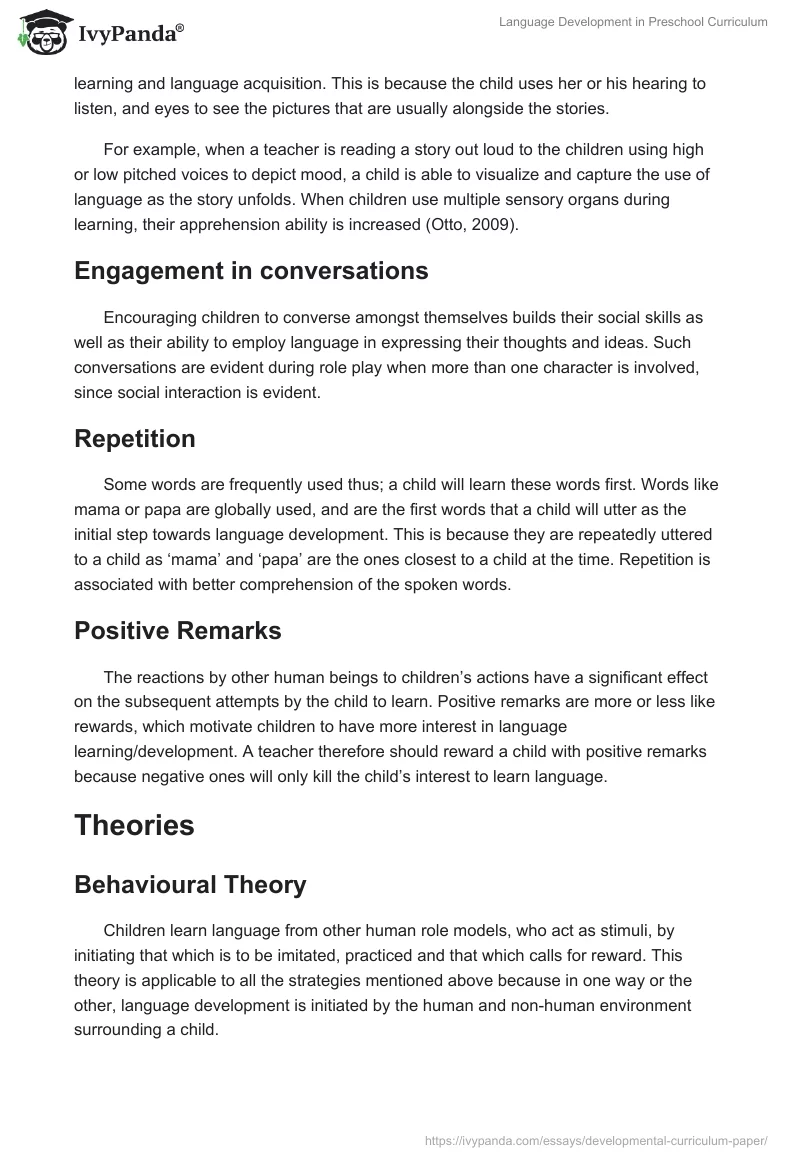Preschool is the onset of development where a child is trying to familiarize her or himself with the surrounding environment. Preschool children are fall in the category of those between three and five years. At this age, simplicity and interaction with others are very essential because the child familiarizes her or himself with that which he or she can see or touch.
Therefore, it is unlikely that a teacher will ask a child to write a composition at this stage. The goal of enhancing language acquisition at this level is to “promote complex verbal reasoning, escalating the use of decontextualized language, and developing personal narrative skills” (Arizona State University, n.d.).
Strategies and Methods
Developing activities directed at developing problem solving skills
Language development should entail instilling problem solving skills in children so that they become open-minded. In so doing, children will be able to come up with impeccable ways of settling down disputes.
Problem solving activities include those which help to develop language and communication skills, which are useful in pacifying an argument(s). As a result, the child is able to develop different special forms of language applicable in different specific situations. For example, the language adopted in comical events is different from that which is used in formal events.
Story-telling and plays
These activities are very enjoyable and interesting to children. As a result of the innate interest of these activities, by the children, language learning becomes an easy task. Storytelling and role plays promote the use of multiple sensory organs in language learning and language acquisition. This is because the child uses her or his hearing to listen, and eyes to see the pictures that are usually alongside the stories.
For example, when a teacher is reading a story out loud to the children using high or low pitched voices to depict mood, a child is able to visualize and capture the use of language as the story unfolds. When children use multiple sensory organs during learning, their apprehension ability is increased (Otto, 2009).
Engagement in conversations
Encouraging children to converse amongst themselves builds their social skills as well as their ability to employ language in expressing their thoughts and ideas. Such conversations are evident during role play when more than one character is involved, since social interaction is evident.
Repetition
Some words are frequently used thus; a child will learn these words first. Words like mama or papa are globally used, and are the first words that a child will utter as the initial step towards language development. This is because they are repeatedly uttered to a child as ‘mama’ and ‘papa’ are the ones closest to a child at the time. Repetition is associated with better comprehension of the spoken words.
Positive Remarks
The reactions by other human beings to children’s actions have a significant effect on the subsequent attempts by the child to learn. Positive remarks are more or less like rewards, which motivate children to have more interest in language learning/development. A teacher therefore should reward a child with positive remarks because negative ones will only kill the child’s interest to learn language.
Theories
Behavioural Theory
Children learn language from other human role models, who act as stimuli, by initiating that which is to be imitated, practiced and that which calls for reward. This theory is applicable to all the strategies mentioned above because in one way or the other, language development is initiated by the human and non-human environment surrounding a child.
Biological/Innatist Theory
This aligns itself with cognitive development. Children tend to acquire language sounds in a predefined sequence based on the first sounds, which have universal bearing. In addition, language development is believed to be a natural process in that children come into the world with a biological propensity, which is a built in device referred to as the language acquisition device (LAD) (Cooter & Reutzel, 2004).
Cognitive
Cognitive theory is applicable in showing language acquisition while factoring in language complexity. Language learning strategies for language acquisition aim at promoting development in terms of memory, cognitive function, meta-cognitive function, compensation, social function and affective ability.
Storytelling and plays for example promote social, memory, cognitive, and meta-cognitive development. Language development should therefore aim at promoting personal development of every child as dictated by the cognitive theory, by enabling the children to acquire problem solving skills by way of example (Chomsky, 2006).
Social Interaction Theory
This theory promotes language development through social interactions like conversations and plays. Social interaction enables students to learn from one another, as well as learn to share their ideas and thoughts.
Curriculum Content
Children should become proactive individuals from the time when they are young, as this enables them to become great leaders. Settling arguments is very critical in life, and the acquiring the right language to do so is also very imperative.
Role plays are an integral element in teaching young children because it enables them to visualize, participate, and gain a better understanding of the events defining language during learning. Lessons for children entail simple activities such as word spelling, reading out loud, and construction of simple sentences.
At this juncture, a teacher can ask the students to repeat what she or he says for example ‘A for apple’. By so doing, the children will be imitating the teacher. In another example, a teacher can ask the children to assume different roles and use language to express and articulate these roles. Such roles are assigned during plays, where a child learns to mimic these roles through language: a very important parameter during role play.
Conversations and social interactions are predicated from reading sessions, where a teacher assigns different students different characters such as ‘Tom’ and ‘Mary’. One student becomes Tom and the other one becomes Mary, and both engage in a conversation by assuming the characteristic roles of the two characters. Every little attempt made by the children is reinforced by the positive remarks such as ‘Good Work’.
These two simple words act as a great motivation factor to children because they will want to receive more positive remarks through more attempts in language development and acquisition. By so doing, this leads to further language development and learning, in an enjoyable and enticing way.
Modifications
Children with special needs, or learning English as a second language, need special support because unlike the other students, they need to practice more, and the teacher needs to go slow on them. Students with special needs may have some form of disability and therefore, teachers should be cautious and patient with such children.
As a way of reinforcing language learning and especially for those who learn English as a second language, and for the special students, video lessons can be used. Video lessons enable these students to learn and practice more when they are by themselves, at home or in the field.
In addition, video-taped lessons are perceived to be interesting thus, the probability that a child will make good use of them is high. Songs are also a way of helping this special category of students. Songs should be designed in a manner that communicates information. As the children are singing the songs, their use of language is improved, and the ability to remember is enhanced.
References
Arizona State University. (n. d.). Enhancing Children’s Language Development in Preschool Classes. Web.
Chomsky, N. Language and Mind. Third edition. (2006). London: Cambridge University Press.
Cooter, R. B., & Reutzel, D. R. (2004). Teaching children to read: Putting the pieces together. Upper Saddle River, NJ: Pearson Education, Inc.
Otto, B. (2009). Language Development in Early Childhood. 3rd ed. New York: Prentice Hall.


